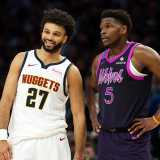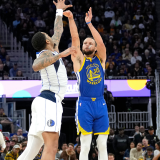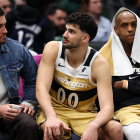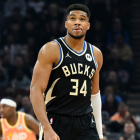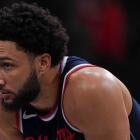The Atlanta Hawks and their heart-pounding 3-point attack
The Atlanta Hawks are using the 3-ball now more than ever, and it's the perfect way to keep them in any game.
 |
| Meet the man who keeps Atlanta within striking distance at all times. (Getty Images) |
You see his feet moving and your heart immediately begins to speed up.
The entire attack is smoke and mirrors. You think the Atlanta Hawks are giving the ball to Al Horford or Josh Smith to get the easy scores inside we've all been taught to seek throughout our basketball education. Aside from Michael Jordan, big men have most often been the dominant forces in the NBA. Look at Bill Russell, Wilt Chamberlain, Bill Walton, Kareem Abdul-Jabbar, Hakeem Olajuwon, Moses Malone, David Robinson, Tim Duncan, and Shaquille O'Neal. These are the legends of the sport.
Sure, you get to sprinkle in the occasional Jordan, Magic Johnson, Larry Bird, Oscar Robertson, Kobe Bryant, and LeBron James from time to time. But really, the big men are what we're supposed to focus on. This is not the case in today's NBA in which big men seem to be the focus to set up the secret weapon.
The Hawks have two very good big men in Horford and Smith. They're not legends by any means, but they're more than capable inside scorers in today's NBA. And when it's applicable they pound the ball into these two guys in the post and look for efficient scoring inside. However, it's nothing more than a sleight of hand to get you to forget about the snipers on the perimeter who are waiting for the opportunity to alter the margin.
Before Tuesday night's 108-103 loss to the Minnesota Timberwolves, Hawks coach Larry Drew talked about the bevy of shooters his team has from the outside and how it has changed their attack this season. They want to spread the floor with their shooters.
They have six players right now shooting 37 percent from 3-point range or better. League average from a 3-point shooter is 35.8 percent. Between Anthony Morrow, Jeff Teague, Lou Williams, DeShawn Stevenson, Kyle Korver and John Jenkins (who actually might be the best shooter of the bunch), Larry Drew has enough space on the floor to build a new arena. Even Josh Smith is shooting 36.5 percent from 3-point range this season.
The Hawks don't want to just shoot 3-point shots, though. Yes, they're shooting 3.4 more attempts per game this season than they did last year and their percentage is up from 37 percent to 37.9 percent. However, they need to get the ball inside to set up their shooters and it's something Drew emphasizes with his team.
With the Hawks down nine points with three minutes left against the Timberwolves, they turned to their best volume 3-point shooter -- Kyle Korver. This is the man who shoots adrenaline into your veins when his feet start moving. If you see Korver standing still in the corner, you don't feel great about it but you know that the defense knows where he is. They haven't lost him.
Once you lose him, you're at the mercy of his lightning quick release.
There were two big 3-pointers he made to get the Hawks back in this game and within a possession of winning a game they didn't start playing with proper effort and focus until halfway into the contest.
 |
The first one actually came after Korver missed a 3-pointer in transition. The Hawks secured the offensive rebound and ran a side pick-and-roll on the opposite side of Korver. He's the great equalizer to just about any defense. By having him on the opposite side, you make the defense choose. Do you give up a long shot and hope it misses or do you protect the paint at all costs?
On this play, Luke Ridnour is paying too much attention to Josh Smith (off screen at the top of the key) while Kirilenko retreats to Korver who is moving to the corner.
 |
Instead of using the screen, Lou Williams attacks baseline. Dante Cunningham is playing for Williams to use the screen, so he's immediately out of position to help. This forces Pek to rotate over to cut off the path to the basket and Kirilenko has to leave the shooter in the corner to rotate over to Zaza Pachulia down low. This is where you'd like Ridnour to make a decision defensively to fly over to the corner shooter.
It would leave Smith open momentarily up top, but that would be on Alexey Shved or Cunningham to rotate over. Instead, Ridnour leaves lots of open space in the middle of the floor, allowing Williams to make a play.
 |
Williams has two options for the pass here. Dump it inside and risk Kirilenko, the Wolves' best defender, making a play against Pachulia or kick it to Korver who Ridnour should be running at right now. This is the spacing that Larry Drew loves for his team to have. You force the defense to make the natural decision -- to protect the paint -- which is exactly what the Hawks want you to do.
 |
Do you see this line? This is the red line of doom. It means you've left too much space for Korver to get his shot off. And I'm not sure anybody has a more effortless release or a quicker release in the NBA. Really, if you leave him an inch, that red line is going to be there.
The second 3-pointer by Korver happened when the Hawks were down just six points with the next possession. The Hawks use a post-up opportunity for Al Horford as chicanery to free up Korver for another 3-point shot.
 |
Williams is setting a screen coming across the top of the key while Pachulia has the ball on the wing. Korver curls around the screen to find Ridnour switching. The Wolves can't afford to let Korver get loose again and cut this to a one-possession game he can tie with another flick of the wrist.
 |
Korver grabs the hand-off and lets Pachulia clear out. This gives an open post-entry pass opportunity to get the ball to Horford in the mid-post and let the Wolves think this is the option Atlanta is looking to get. But really this is just a smokescreen by the Hawks to set up the shot they want.
 |
After Horford receives the ball, Korver is running a basic flare off of a screen by Pachulia. There is no way Ridnour is fighting through a Pachulia screen and Pekovic simply isn't fleet of foot enough to defend and close out on the perimeter against someone like Korver.
Korver uses screens as well as anybody. His feet start moving and he runs you into his teammate like an action star trying to get rid of pursuers in a car chase. He's leaving minimal space between himself and the man screening for him. It allows him to keep moving balanced to get out the perimeter, and as he's catching any pass, he's squaring his body up to the basket.
 |
Once his body gets squared up, he sets his feet and that red line of doom appears once again. Pekovic is in terrible position to even think about bothering Korver's shot. He knocks down the three, and the Hawks have new life.
This is the strategy of the new-look Hawks. They don't go into isolation nearly as much as they used to. In their 73 games (including playoffs) last season, the Hawks averaged 12.5 isolation possessions in which the offensive player attempted a shot, turned the ball over, or got to the free throw line. This season, Synergy Sports tracks them at 8.1 isolation possessions per game.
The Hawks find ways to get the ball inside to keep you guessing on whether you should protect the basket or stay out on shooters. It's misdirection to get you forgetting about the shooter who is beginning to move his feet to create space for an outside dagger. It's the way to speed up your heart and get you to worry about a flick of the wrist from 23 feet away.
It's the age of the 3-point shot in the NBA, and the Hawks are prepared for it.


